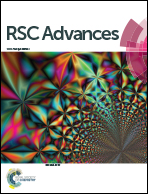Determination of ultra-trace amounts of chlorophenols in rain, tap and river water by an electrochemically controlled in-tube solid phase microextraction method†
Abstract
An electrochemically controlled in-tube solid phase microextraction method has been developed for the extraction of ultra-trace amounts of three groups of chlorophenols (CPs): mono-chlorophenols, di-chlorophenols and tri-chlorophenols in rain, river and tap water samples. Determination of the extracted CPs was performed by high performance liquid chromatography and UV detection. A new polypyrrole/Nafion composite coating was electrochemically synthesized on the inner surface of the stainless steel capillary as a working electrode (anode) for the electrochemical extraction of chlorophenols from water samples. By passing the sample solution over the inner surface of the coated electrode, the chlorophenols could be extracted by applying a positive potential under flow conditions. This method is an ideal sample preparation technique because it is easy to automate, solvent-less, and inexpensive. Some important experimental parameters that could affect the extraction and separation of the analytes, such as the extraction and desorption voltages, the pH of sample solution, the extraction and desorption times and the flow rates of the sample solution and eluent were investigated and optimized. Under optimal conditions, the limits of detection were in the range of 0.07–0.20 μg L−1. This method showed good linearity for chlorophenols in the range of 0.20–500 μg L−1, with coefficients of determination greater than 0.9984. The inter- and intra-assay precision (RSD%, n = 3) was in the range of 5.4–6.8% and 4.0–5.9% at three concentration levels of 2, 10 and 20 μg L−1, respectively. The validated method was successfully applied for the analysis of 2-chloro-, 4-chloro-, 2,3-dichloro-, 2,4-dichloro-, 2,3,6-trichloro-, and 2,4,6-trichloro phenols in water samples.


 Please wait while we load your content...
Please wait while we load your content...